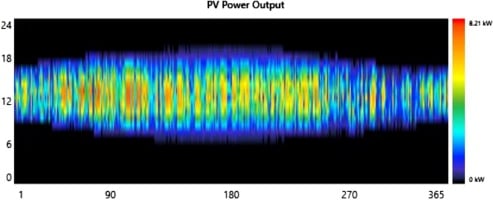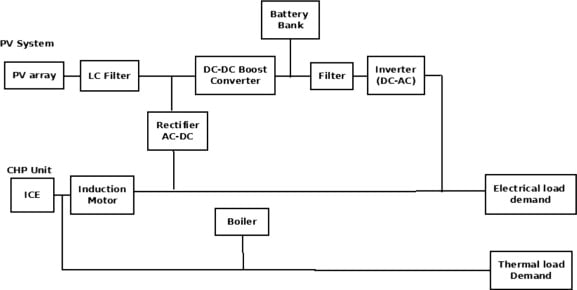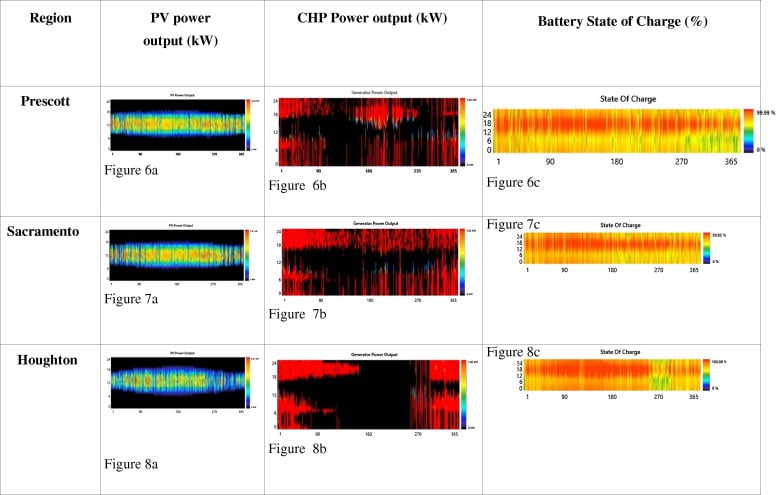
Until recently, the relatively high levelized cost of electricity from solar photovoltaic (PV) technology limited deployment; however, recent cost reductions, combined with various financial incentives and innovative financing techniques, have made PV fully competitive with conventional sources in many American regions. In addition, the costs of electrical storage have also declined enough to make PV + battery systems potentially economically viable for a mass-scale off-grid low-emission transition. However, many regions in the U.S. (e.g. Northern areas) cannot have off-grid PV systems without prohibitively large battery systems. Small-scale combined heat and power (CHP) systems provide a potential solution for off-grid power backup of residential-scale PV + battery arrays, while also minimizing emissions from conventional sources. Thus, an opportunity is now available to maximize the use of solar energy and gain the improved efficiencies possible with CHPs to deploy PV + battery + CHP systems throughout the U.S. The aim of this study is to determine the technical viability of such systems by simulating PV + battery + CHP hybrid systems deployed in three representative regions in the U.S., using the Hybrid Optimization Model for Electric Renewable (HOMER) Pro Microgrid Analysis tool. The results show that the electricity generated by each component of the hybrid system can be coupled to fulfill the residential load demand. A sensitivity analysis of these hybrid off grid systems is carried out as a function capacity factor of both the PV and CHP units. The results show that conservatively sized systems are technically viable in any continental American climate and the details are discussed to provide guidance for both design and deployment of PV + battery + CHP hybrid systems to reduce consumer costs, while reducing energy- and electricity-related emissions.
Highlights[edit | edit source]
- Simulated PV + battery + CHP hybrid systems deployed in three U.S. regions.
- Used hybrid optimization model for electric renewable pro microgrid analysis.
- Limited size of each sub-module to singe family house size.
- Results show that the electricity generated meets residential load demand.
- Hybrid systems are technically viable in hot, moderate and cold climates in U.S.
System set up[edit | edit source]
Case study results[edit | edit source]
The results show that conservatively sized systems are technically viable in any continental American climate and the details are discussed to provide guidance for both design and deployment of PV + battery + CHP hybrid systems to reduce consumer costs, while reducing energy- and electricity-related emissions.
See also[edit | edit source]
- PV and CHP Hybrid System
- Hybrid photovoltaic-trigeneration systems
- Simulations of Greenhouse Gas Emission Reductions from Low-Cost Hybrid Solar Photovoltaic and Cogeneration Systems for New Communities
- Photovoltaic plus combined heat and power
- PV and CHP Literature review
- Emerging economic viability of grid defection in a northern climate using solar hybrid systems
- The Potential for Grid Defection of Small and Medium Sized Enterprises Using Solar Photovoltaic, Battery and Generator Hybrid Systems
- Examining interconnection and net metering policy for distributed generation in the United States
- Economic viability of captive off-grid solar photovoltaic and diesel hybrid energy systems for the Nigerian private sector
- HOMER
- Energy Policy for Energy Sovereignty: Can policy tools enhance energy sovereignty?
- The energy crises revealed by COVID: Intersections of Indigeneity, inequity, and health
- Decentralized Renewable Hybrid Mini-Grids for Rural Communities: Culmination of the IREP Framework and Scale up to Urban Communities
- Demonstration of the integrated rural energy planning framework for sustainable energy development in low-income countries: Case studies of rural communities in Nigeria
- Economics of Grid-Tied Solar Photovoltaic Systems Coupled to Heat Pumps: The Case of Northern Climates of the U.S. and Canada
- Decarbonizing rural residential buildings in cold climates: A techno-economic analysis of heating electrification
- Strategic Investment in Open Hardware for National Security
- Open source decarbonization for a sustainable world
- Can grid-tied solar photovoltaics lead to residential heating electrification? A techno-economic case study in the midwestern U.S.







